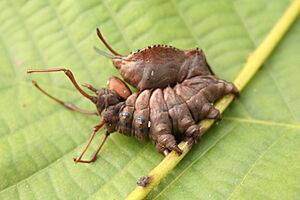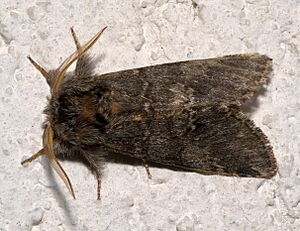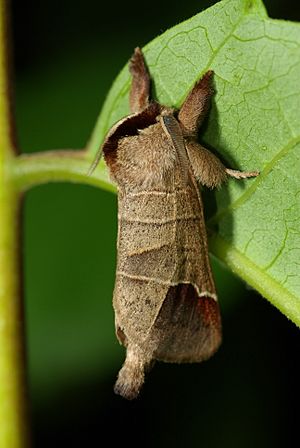List of moths of Great Britain (Notodontidae) facts for kids
The family Notodontidae is a group of moths often called "prominent moths" or "kitten moths." These names come from their unique shapes and features. For example, some have tufts of hair or bumps on their wings or bodies that make them look "prominent." "Kitten moths" are usually smaller and have a softer appearance. There are 27 different types of Notodontidae moths that have been found in Great Britain.
Contents
Meet the Notodontidae Moths
Notodontidae moths are known for their interesting shapes and sometimes unusual caterpillars. They are usually medium to large-sized moths. Many of them have a resting posture where their wings are folded tightly around their body, making them look like a broken twig or a piece of bark. This helps them blend in with their surroundings and hide from predators.
Notodontinae: The True Prominents
This is the largest group within the Notodontidae family. Many of the moths here are named "prominent" because of their distinct features.
- Cerura vinula, the puss moth — This moth is found all over Great Britain. Its caterpillar is very striking, with a green body and a large, intimidating face-like marking.
- Furcula bicuspis, the alder kitten — Found in specific areas like the south-west and south-east.
- Furcula furcula, the sallow kitten — Common throughout Great Britain.
- Furcula bifida, the poplar kitten — Found in southern and central parts of the country.
- Notodonta dromedarius, the iron prominent — You can find this moth across Great Britain.
- Notodonta torva, the large dark prominent — This is a rare immigrant to Great Britain, meaning it usually flies in from other places.
- Notodonta tritophus, the three-humped prominent — Another immigrant species.
- Notodonta ziczac, the pebble prominent — This moth is common throughout Great Britain.
- Pheosia gnoma, the lesser swallow prominent — Found everywhere in Great Britain.
- Pheosia tremula, the swallow prominent — Also found throughout Great Britain.
- Ptilodon capucina, the coxcomb prominent — A common moth found all over.
- Ptilodon cucullina, the maple prominent — Found in localized areas in the south and east.
- Odontosia carmelita, the scarce prominent — Found in specific spots in the south and north.
- Pterostoma palpina, the pale prominent — Common throughout Great Britain.
- Leucodonta bicoloria, the white prominent — Sadly, this species is now extinct as a resident in Great Britain, though it might sometimes arrive as an immigrant.
- Ptilophora plumigera, the plumed prominent — Found in the south-east. This species is considered "Nationally Scarce A," meaning it's quite rare.
- Drymonia dodonaea, the marbled brown — Found in localized areas in the south, central, and north-west.
- Drymonia ruficornis, the lunar marbled brown — Common throughout Great Britain.
- Gluphisia crenata vertunea, the dusky marbled brown — A rare immigrant species.
Pygaerinae: The Chocolate-Tips
This subfamily includes moths known as "chocolate-tips," named for the brownish tips on their wings.
- Clostera pigra, the small chocolate-tip — Found throughout Great Britain but is "Nationally Scarce B," meaning it's not very common.
- Clostera anachoreta, the scarce chocolate-tip — Found in the south-east. This moth is listed in the "Red Data Book," which means it's very rare and needs protection.
- Clostera curtula, the chocolate-tip — Common in southern England and found in specific areas further north.
Phalerinae: The Buff-Tip
This subfamily has only one species listed here, but it's quite unique!
- Phalera bucephala, the buff-tip — This moth is found all over Great Britain. It's famous for looking exactly like a broken twig when it rests, making it almost impossible to spot!
Heterocampinae: Unique Shapes
This group includes some of the most unusually shaped moths and caterpillars.
- Stauropus fagi, the lobster moth — Found in the south and west-central parts of Great Britain. This moth gets its name from its amazing caterpillar, which looks a bit like a lobster!
- Harpyia milhauseri, the tawny prominent — A rare immigrant species.
- Peridea anceps, the great prominent — Found in localized areas in the south, west-central, and north-west.

Dilobinae: The Figure of Eight
This subfamily has one interesting moth named after a number.
- Diloba caeruleocephala, the figure of eight — Found in the south, central, and north of Great Britain. Its name comes from the markings on its wings.
Conservation Efforts
Some of these moths are part of the UK Biodiversity Action Plan (BAP). This plan helps protect species that are rare or whose numbers are decreasing. Species marked with a double-dagger symbol (‡) are part of this plan. If there's also an asterisk (‡*), it means they are listed for research purposes to help us learn more about them and how to protect them.




